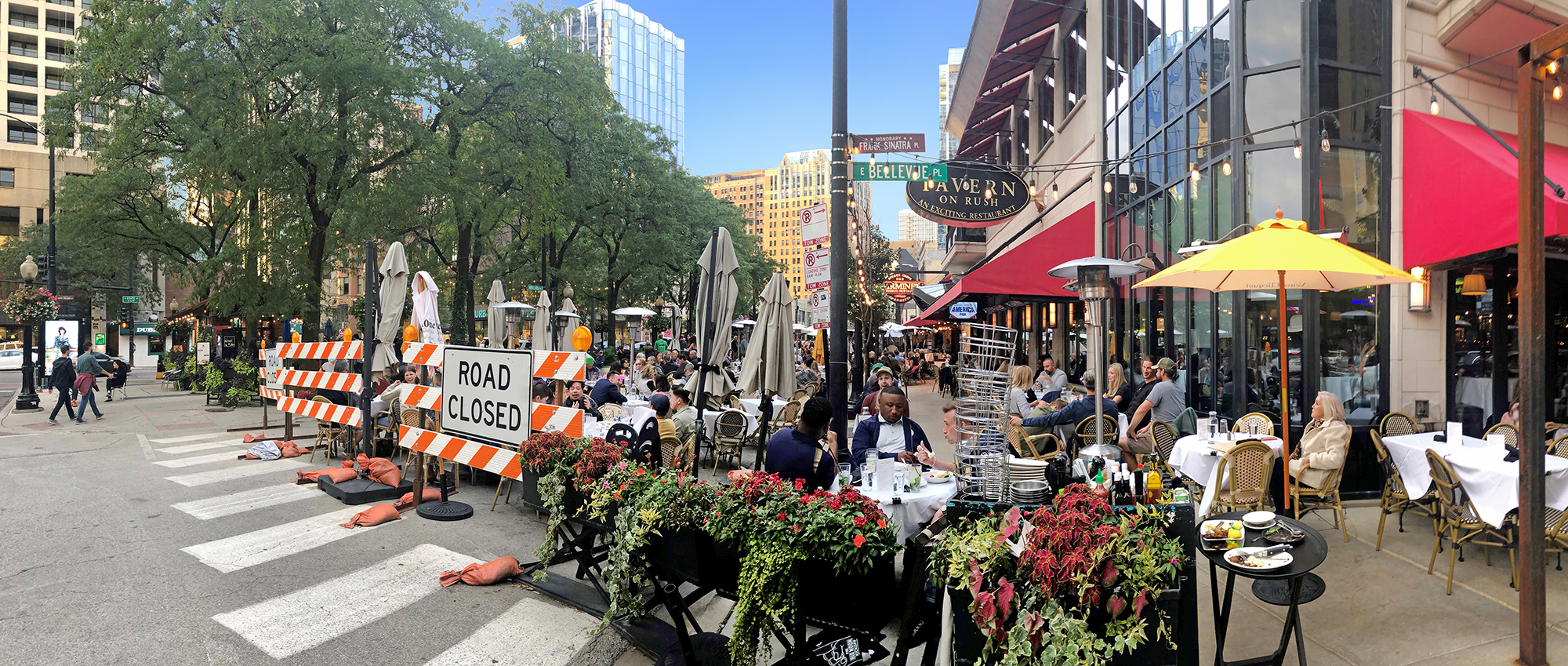Due to the pandemic, the bustle of Chicago city living ground to a halt when quarantine was sanctioned. Like many cities, walkable neighborhoods became ghost towns and joggers turned streets into their own personal running track. As directed, downtown businesses closed, parks and recreational areas locked gates while retail storefronts went dark. Seen as essential, some restaurants held a semblance of normalcy, offering delivery and pick-up service. These sudden changes forced businesses to adapt and develop new strategies for their operations.
Some closures were temporary while others permanent. Due to these transformations, cities are becoming more flexible in how buildings and streetscapes are being programmed. It is vital to define programs to suit these vacancies and return to a more vibrant community. As designers, we adapt buildings, re-imagine spaces and find new opportunities for design. Responding to Chicago and cities alike with innovative, insightful programmatic prospects will benefit neighborhoods, eventually providing a silver lining to the pandemic.
Do you see anything aspirational being planned for the city?
Darlene Brown: City leaders have joined together to find opportunities for growth despite economic uncertainty. Chicago’s 2021 Architecture Biennial paired community groups with renowned international designers to rethink abandoned urban spaces. What is intriguing is the way the exhibit will be distributed throughout Chicago. According to their website, the content of the show will have depth and be rewarding to those who visit, but the big success here is the show will take place in vacant urban lots, storefronts, community gardens and decommissioned schools— virtually and physically. Delivering the exhibition in this manner activates struggling neighborhoods in a creative and thoughtful way.
How is Chicago tackling the empty storefronts and abandoned properties due to the pandemic’s economic fallout?
DB: The city is transforming and re-programming vacant ground level spaces by looking at alternatives to the typical retailers and restaurants. Media and large entertainment companies are utilizing the vacant spaces to grow their brands and produce interactive experiences. The city along with landlords are open to re-imagining these spaces and creating new types of places for people to engage. These new programs consist of pop-ups from retail and entertainment to restaurants.
Are there any noteworthy examples in town?
DB: There are several taking place in many of the large vacant retail spaces. For instance, “The Office” Experience is coming to Chicago on the “Mag Mile” in the former Forever 21 store. This interactive experience modeled from “The Office” television series will draw visitors into the venue with set recreations, specialty props and costumes used on the TV show. Creating unique entertainment places such as this will draw people, economically activate the area, and eliminate vacancy along a prominent block.
How have you begun to engage in these types of design activities?
DB: Our hospitality and entertainment clients are asking for big ideas for their new project developments. We craft stories that dovetail with the experience while providing direction for the interior design. Our current projects and relationships in the restaurant and hospitality industry keep us engaged. We are seeing operators think differently and participating in ways for them to shine in the market. Our clients are pushing their menu ideas and food concepts finding unique offerings while we generate an interior space to complete the overall story. The synergy between our teams is rewarding and seeing our clients succeed is what drives us.
What ways did the city provide support to the hospitality and restaurant community during the COVID-19 Pandemic?
DB: In the summer of 2020, Downtown Chicago reopened restaurants with a reduced capacity and allowed neighborhoods with multiple restaurants on their block to shut down streets and utilize the area for outdoor dining, extending restaurant capacity. Before winter hit, the Chicago Mayor proposed the “Chicago Winter Dining Challenge.” This challenge led to many clever design solutions for temporary structures and makeshift outdoor patios. These new additions provided an element of surprise to the neighborhood and solved restaurant capacity struggles. Many cities realized the importance of suspending typical rules and regulations. The progressive minded shift led to re-configured traffic patterns generating new walkable
streetscapes and served the community well.
Will the shifts in the city generate long term benefits?
DB: Noticing how quickly cities adapted was one of the biggest rewards we experienced. New programming ideas produced conversations and opened opportunities for arts, architecture and culture allowing further enrichment to our communities. These shifts ideally will continue to provide new ways of envisioning our towns and provide a means for reactivation. It is inspiring as designers to see zoning flexibility and new programmatic variations occur. These changes are the silver linings that inspire us.

